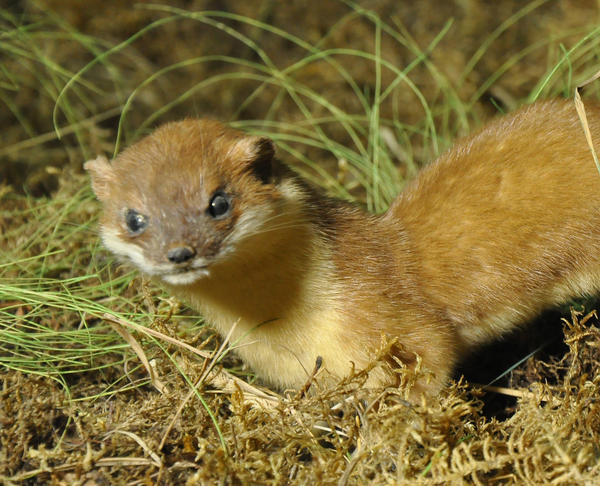The stoat, otherwise ermine (Mustela erminea), is a predator of the weasels and stoats family (Mustelidae). It is a small animal, looking like but larger than the least weasel. The males are 17-38 cm long, the females about half that size. The stoat is 70 to 260 grams in weight.
It has protective coloration, helping it to melt into the background. In summer, it is brown to dark brown, in winter the fir colour changes for pure white. This species is different from the least weasel or mountain weasel due to a black tip of the tail, which it has at all seasons.
The stoat is an agile and deft animal. It is fast but somewhat fidgety. When hunting, it can cover a distance of up to 15 km in one day. However, this is an exceptional daily distance which they cover only when they are desperate for food.
The stoat is an agile and deft animal. It is fast but somewhat fidgety. When hunting, it can cover a distance of up to 15 km in one day. However, this is an exceptional daily distance which they cover only when they are desperate for food.
On snow, the stoat moves in jumps up to 50 cm long, jumping off the ground with both hind legs. When it runs it often changes direction, sometimes plunging into snow. It is an excellent swimmer and tree climber. In most instances, it is on a tree that a stoat waits out when followed by a larger animal or threatened otherwise.
Summer is the rut season for stoats. Stoat pregnancy has a latent period when the embryo starts developing only a few months after fertilization.
The stoat is silent as a rule, but when excited it makes loud chirping noises, it can twitter, hiss, and even bark. This little carnivore is very brave and blood-thirsty, when driven into a corner it dares even dash against humans. The natural enemies of the stoat include: the common red fox, marten, badger, carnivorous birds. At times, even domestic cats can catch them.
Sometimes the stoat lives in villages and towns; in larger cities, it can only be found where rats are abundant, that is, at dumps or vegetable storage sites. It feeds on rodents or, less frequently, other small animals, carrion, berries. Occasionally, it tracks major predators, picking up the leftovers of their kill.
Summer is the rut season for stoats. Stoat pregnancy has a latent period when the embryo starts developing only a few months after fertilization.
The stoat is silent as a rule, but when excited it makes loud chirping noises, it can twitter, hiss, and even bark. This little carnivore is very brave and blood-thirsty, when driven into a corner it dares even dash against humans. The natural enemies of the stoat include: the common red fox, marten, badger, carnivorous birds. At times, even domestic cats can catch them.
Sometimes the stoat lives in villages and towns; in larger cities, it can only be found where rats are abundant, that is, at dumps or vegetable storage sites. It feeds on rodents or, less frequently, other small animals, carrion, berries. Occasionally, it tracks major predators, picking up the leftovers of their kill.


